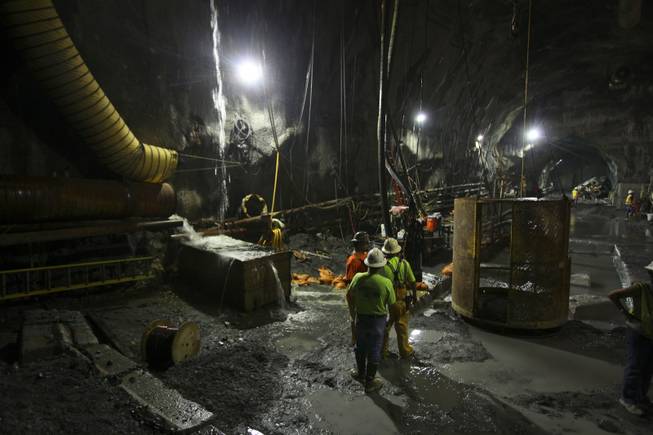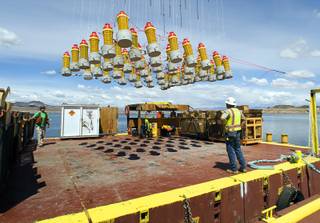
Jim Wilson / The New York Times
Workers build a water intake tunnel under Lake Mead near Boulder City, Nev., on Sept. 8, 2010. Federal estimates in August showed that Lake Mead could drop below a crucial demarcation line of 1,075 feet, which would trigger a temporary reduced distribution plan to Arizona and Nevada.
Tuesday, June 4, 2013 | 2 a.m.
Sun coverage
- More news about Las Vegas water issues
- $650 million project OK’d to ensure water to LV (5-20-2005)
- Coroner ID’s victim in Lake Mead industrial accident (6-12-2012)
- State officials investigating cause of fatal tunnel breach (6-12-2012)
- Contractor gets OK to resume tunneling for water intake project at Lake Mead (6-26-2012)
- Las Vegas Sun topic: For Want of Water
Around 4:30 p.m. on June 11, 2012, a team of a dozen workers toiled 600 feet below the surface of Lake Mead on a project to build a third intake to provide water to the Las Vegas Valley.
As a 1,600-ton, 600-foot-long drill bored its way into the rock bed below the lake, several of the workers followed behind, erecting a series of concrete rings to stabilize the newly excavated tunnel that stretched 24 feet across.
The 134th of an eventual 2,600 rings had been completed earlier in the day when the swing shift crew began work installing the six segments needed to complete ring 135.
As they began retracting the three hydraulic rams that were used to install the ring segments, a loud pop was heard. One of the segments of ring 134 shifted four inches, releasing a jet of pressurized mortar and grout that struck and killed 44-year-old Thomas Albert Turner.
Turner’s death and the injury of another worker in the accident halted progress on the third intake straw and added a stark human cost to the hundreds of millions of dollars the Southern Nevada Water Authority is spending on a project it says is crucial to ensuring long-term access to potable water in the valley, even as the reservoir levels drop in the face of a prolonged drought.
The two-week delay in construction was one of several disruptions that has slowed progress on the 3-mile tunnel that will connect with an intake straw at Lake Mead to transport water to the nearby pumping and treatment stations that deliver water to homes and businesses in the valley.
The $817 million project originally was scheduled to be completed this summer. Now it won’t be finished until 2014, possibly 2015, after several setbacks, including the fatal accident and a series of breaches in 2010 that flooded the tunnel and forced crews to back up and start digging along a new path.
Turner’s death prompted the use of enhanced restraints when installing the concrete segments, but the project’s contractor, Vegas Tunnel Constructors, was not cited for wrongdoing after a three-month investigation by the Occupational Safety and Health Administration found the company had no knowledge of the potential hazard because it had never occurred before in similar projects.
Since then, the tunnel boring machine has dug its way farther under the lake at a rate of about 30 feet per day, except for a three-month stretch when the project was shut down for repairs. There have been no reports of additional serious accidents at the site.
•••
When the drill reaches the third intake structure that has already been installed in the bed of Lake Mead, it will provide a buffer for the Southern Nevada Water Authority against the continued drop in the reservoir's water level, which currently sits at 1,108 feet above sea level.
Two intake structures currently draw water from the lake, but the first and oldest could become obsolete if the lake level drops below a 1,050-foot threshold. At that level, water would no longer be able to enter the intake.
If the first intake were to go offline, it would halve the amount of water the authority is able draw from Lake Mead, which accounts for 90 percent of the region’s supply. It could lead to water shortages in the summer months.
Lake levels have dropped nearly 100 feet in elevation over the past decade because of widespread drought, dipping as low as 1,081 feet in 2010 before rebounding slightly since then.
Programs to reduce water consumption by residents have proved effective in slowing the decline, but not enough to halt the slow shrinking of the reservoir’s supply.
“When we look at what consumption has been doing, that’s all customer behavior. When we look at what the lake levels have been doing, most of that is Mother Nature, which is something we don’t have control over,” water authority spokesman Bronson Mack said. “It’s nice that we’ve seen a drop (in consumption), but we still have to protect our access. … As a water agency, we don’t have the luxury to stand idly by and hope. We have to take the action required of us to make sure our community continues to have water.”
When the lake level might drop below the first intake is hard to predict, Mack said, but the third intake, which sits much lower than the other two at 860 feet above sea level, is meant to ensure continued access to water if and when that happens.
The costly project will stretch the water authority’s budget, which has suffered as funding from lucrative connection fees dried up when development stopped during the recession. It also has led to rate hikes for water users, including a monthly surcharge imposed last year. That surcharge amounted to $5 per month for homes with a standard-size water meter, but commercial businesses with larger meters for uses such as fire sprinkler systems said their bills increased by several thousand dollars a month because of the new charge.


Join the Discussion:
Check this out for a full explanation of our conversion to the LiveFyre commenting system and instructions on how to sign up for an account.
Full comments policy